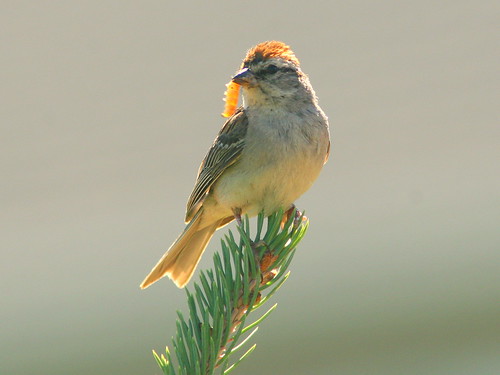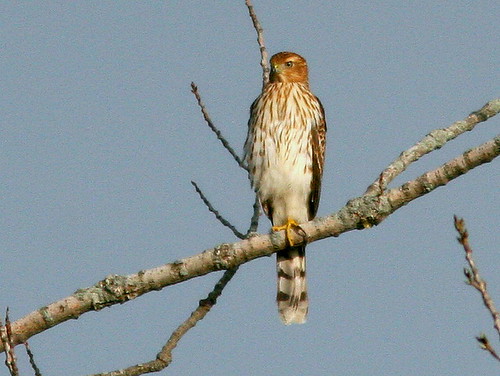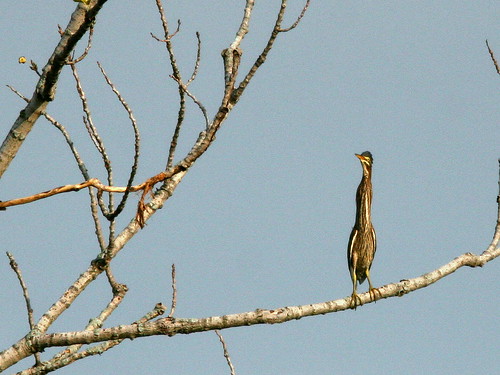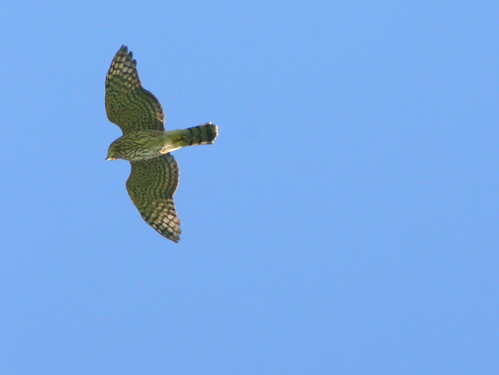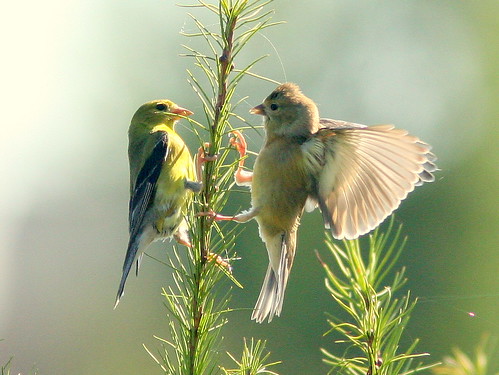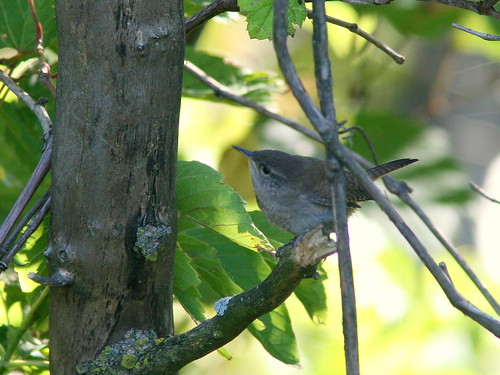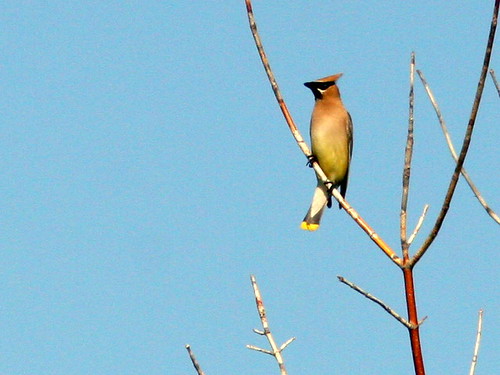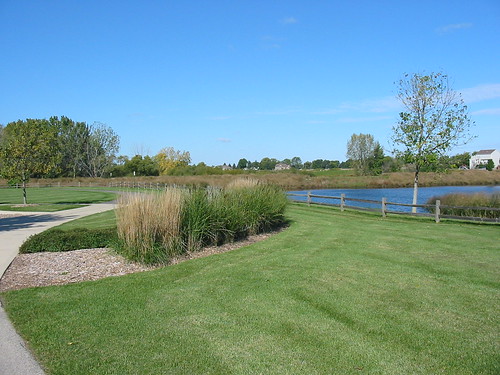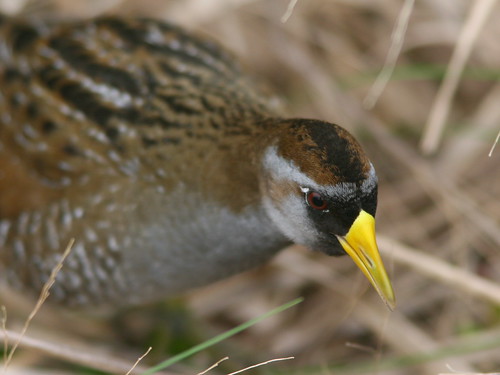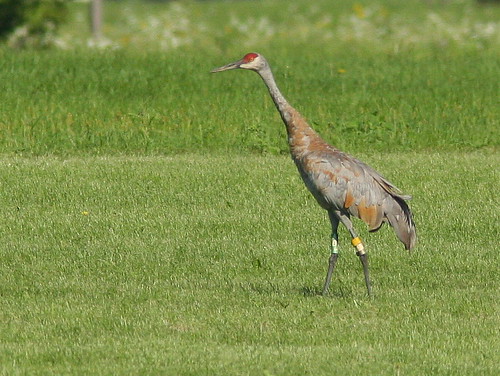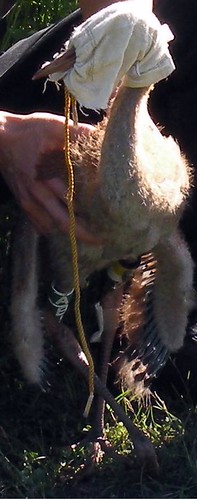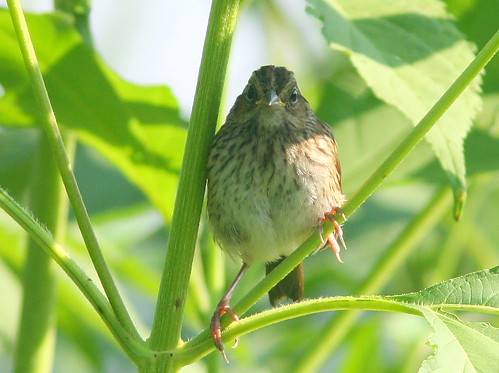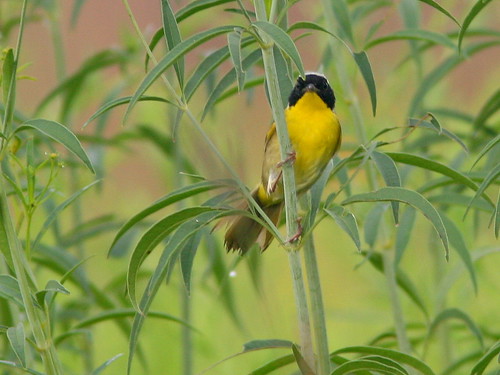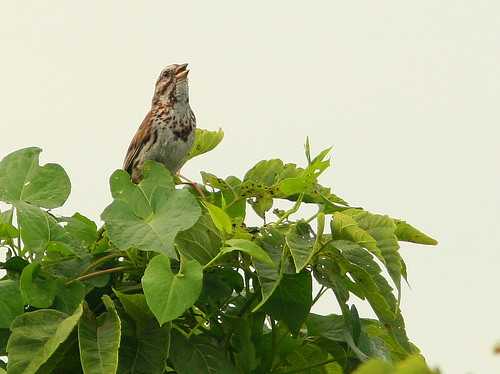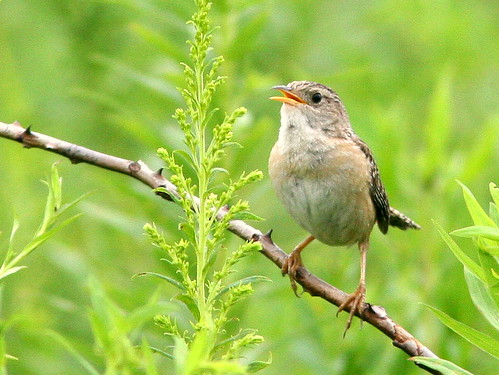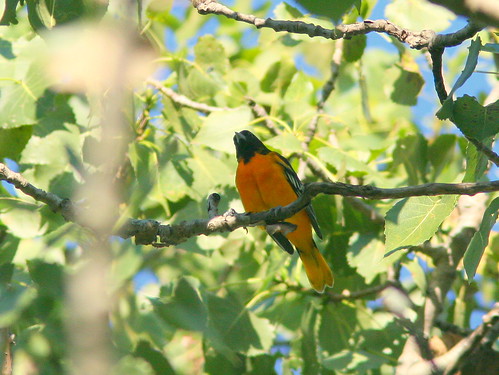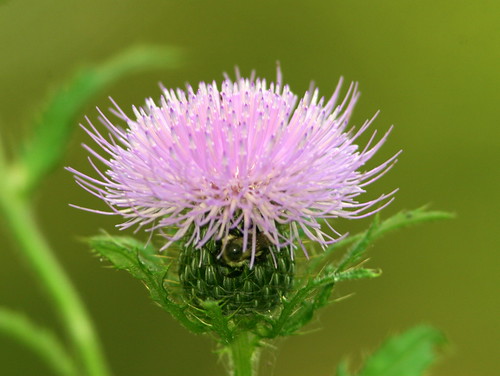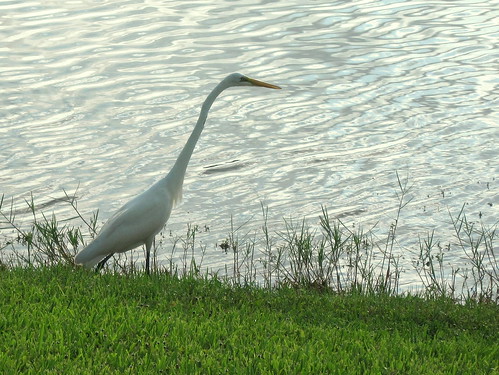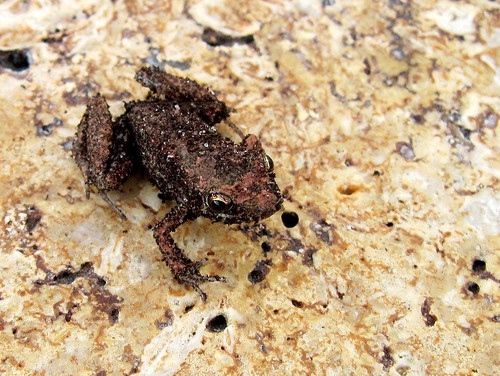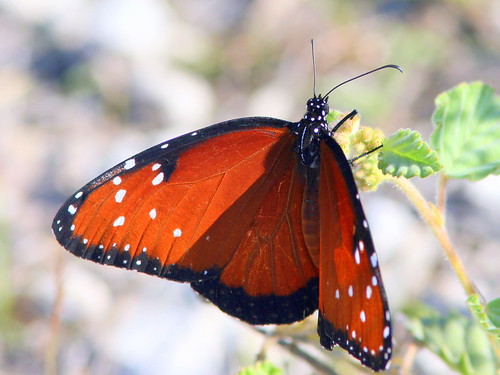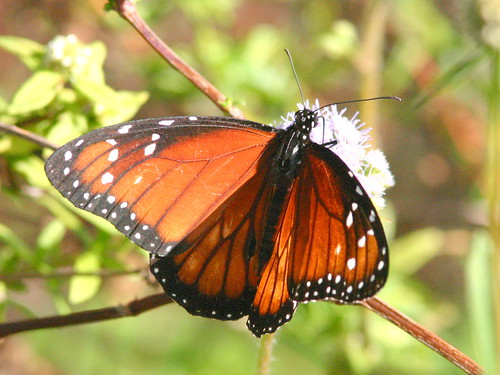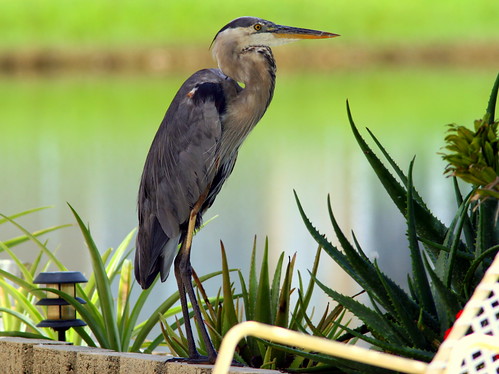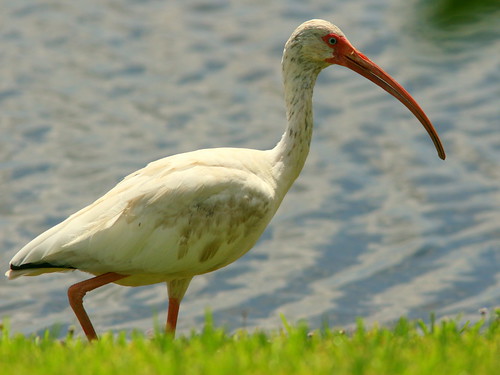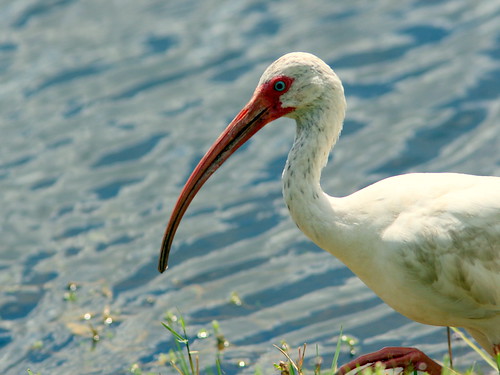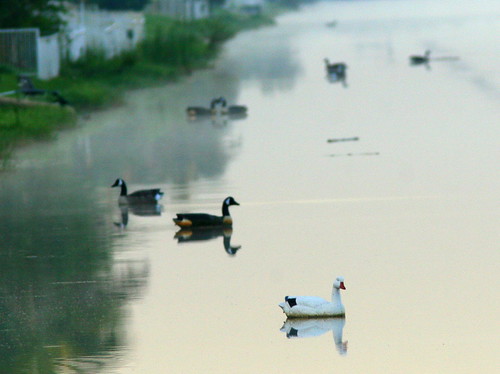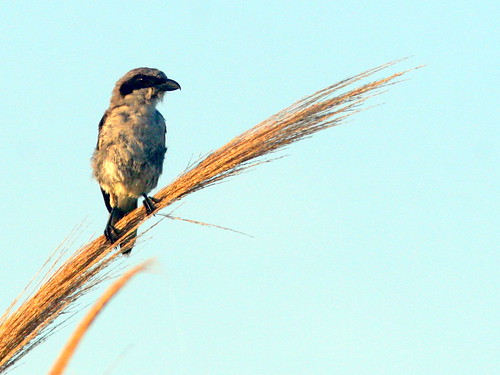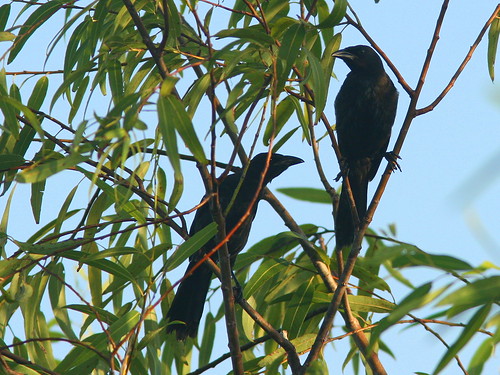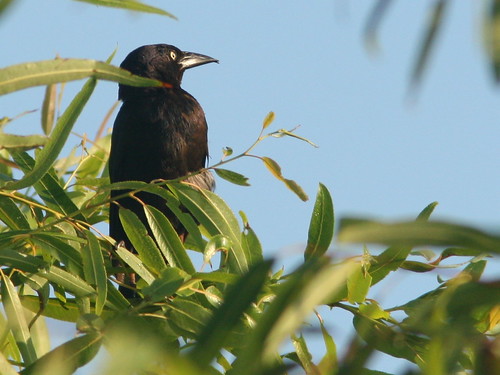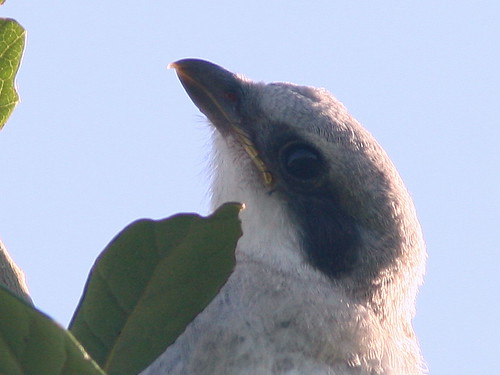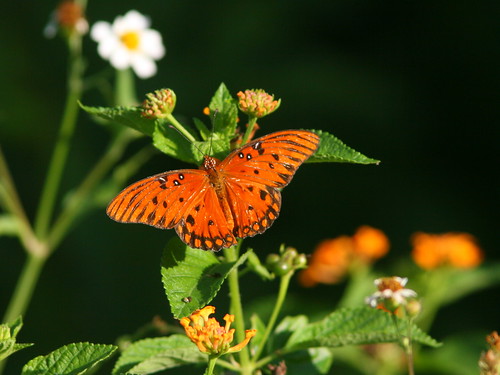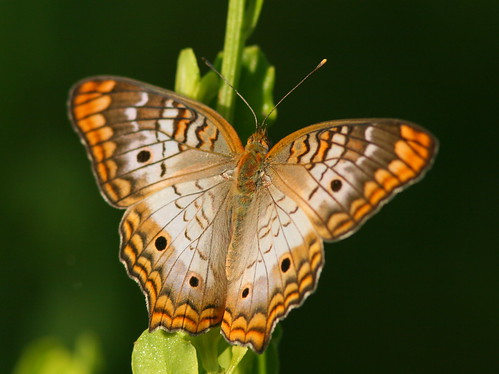Chimney Swifts have nested above the fireplace of our daughter’s house for a couple of years, and her family has been kind enough to not replace the chimney cap that blew off in a wind storm. Here, one of the adults descends into the chimney to feed the nestlings.
It was very difficult to get this shot, as the birds are very fast fliers. Most of my attempts yielded only blue sky, but click on the photo to see one “near miss” that illustrates the tail barbs which help the bird rest on vertical surfaces):
While photographing the swifts, I heard the call of a Chipping Sparrow, bringing an insect to a fledgling hidden in a small spruce tree in the next yard:
Nearby, this is our own “front yard.” It was home this spring to Red-winged Blackbirds, Horned Larks, Meadowlarks, Vesper and Savannah Sparrows, but now is populated by migrating Canada Geese and Killdeers: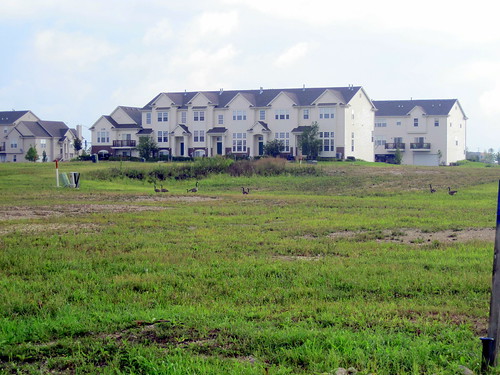
Development has been stalled due to the poor housing market, allowing the disturbed land around our North Aurora (Illinois) condo to return to grass. I’ve been carrying my little point & shoot Kodak Power Shot 1100 IS on our “power walks” along the abandoned streets. During our early morning walks we have encountered a family of Red-tailed Hawks, presumably the same ones that nested in the Mooseheart School property about a quarter of a mile from our second home. They like to roost on the street lights along the vacant roads that make up the infrastructure of a now-abandonded housing development. There appear to be three immature hawks, accompanied by one or two adults. The youngsters are very noisy. We don’t think they are asking to be fed, and they seem to be making hunting forays on their own.
This immature Red-tailed Hawk is basking in the morning sun. Click on this photo for more views:
Hoping to re-locate the color-banded Sandhill Crane (reported in this previous post), we returned to Jones Meadow Park on two different mornings the following week.
A Great Blue Heron casts its reflection in the quiet waters of the retention pond near the entrance of the park: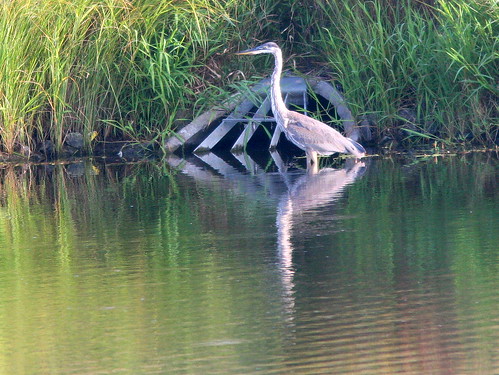
Just above the wetlands next to the pond, a Cooper’s Hawk perches motionless near the top of a dead Cottonwood:
In the same tree, and just below the hawk, a Green Heron, eyes it nervously:
The heron flies down into the wetlands, providing us with a better view of its crisply patterned plumage:
We failed to find the color-banded crane, but were surprised to see two spotted fawns resting in the high grass only about 15 feet from the path. They were so close that I could only fit their faces into the viewfinder of my telephoto lens. No adult deer was about, and both fawns posed nicely for their portraits before moving into the shelter of the woodlands.
Here is the smaller of the twins:
A bird does not need to be rare to be beautiful:
A fledgling American Goldfinch begs for food: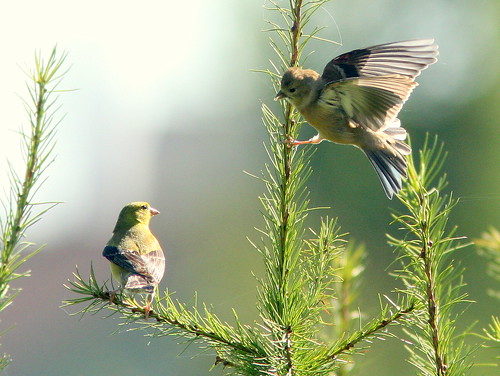
While most seed-eating birds provide their young with high-protein insects, goldfinch parents feed their offspring only seeds, in a rich “milk” that is fortified by proteins secreted by the adult bird’s crop:
Rose-breasted Grosbeaks are now getting scarce. This is a first year male:
At first glance, this bird looked like a Tennessee Warbler because of its small pointed bill and short tail, but on close examination, note absence of any trace of wing bars and yellowish sides of its breast, characteristics of a Warbling Vireo: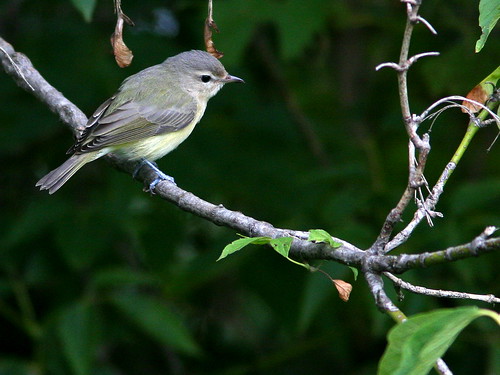
This view of the Warbling Vireo better shows the color of its undersides: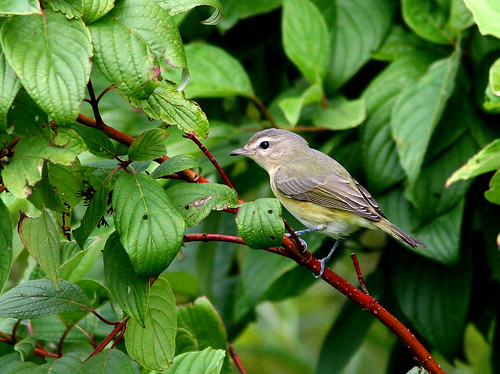
In the same thicket with the vireo is this Blue-gray Gnatcatcher:
A Belted Kingfisher struggles to swallow a large fish:
A House Wren scolds from the safety of a trail-side shrub:
A few Cedar Waxwings are wandering about in search of berries:
Google earth image of Jones Meadow Park: 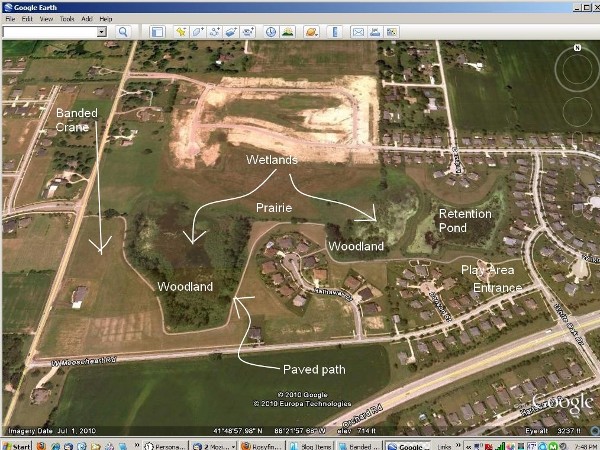
Jones Meadow Park in North Aurora, Illinois is a short walk from our second home. Our granddaughters enjoy playing on the swings and slides. For us it is a small oasis, amid suburban housing and cornfields crowded to property lines without hedgerows to separate them. Wild creatures are attracted to this island of favorable habitat.
An 0.7 mile asphalt footpath winds along the southern periphery of a combination of wetlands, prairie and woodlands. An expansive area of mowed lawn grass serves as a buffer between homes on the other side of the path. Many of the homeowners maintain bird feeders, attractive to sparrows, chickadees and finches. The paved walk is especially welcome during rainy times, when some of our other birding areas can get quite soggy underfoot. A short grassy side path leads north between the pond and the eastern portion of the wetlands, often affording close views of its inhabitants.
Retention pond at Jones Meadow Park:
East Wetlands:
A Muskrat munches on cattail stems:
Earlier this year, a Sora strolled at the edge of the grassy path, almost underfoot:
A pair of Sandhill Cranes spent the whole summer here. Local residents told us they nested at the northern edge of the wetlands, but we never observed nest or chcks (called “colts”). In our experience, most of the cranes travel around in pairs or small (presumably family) groups of two to four birds.
These Sandhill Cranes are most likely the resident pair that we have been seeing at Jones Meadow Park: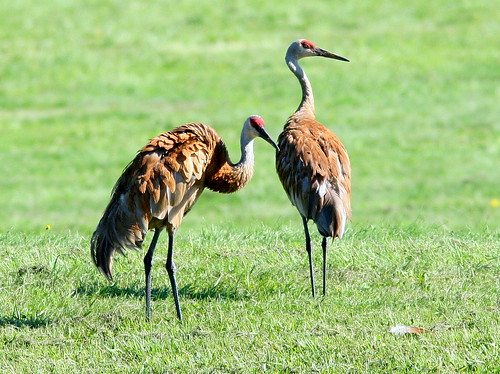
This past week we encountered a solitary crane in the mowed prairie at the western end of the park. We noted that it had colored bands on the upper portion of its legs: three green bands on the right leg, and yellow, white and silver bands on the left. There were large white letters on the green bands, but we could not read them with binoculars. I took several photographs, and was able to read the letters from the computer screen.
It wore six bands, three on each leg:
Reading down, note green bands with white letters A, B, H on right leg, and yellow-white-silver on left leg:
I posted this information on IBET (Illinois Birders Exchanging Thoughts) and, based upon feedback about how to report a color banded bird, I contacted Anne Lacy, Long Term Crane Research Coordinator at the International Crane Foundation
Anne referred my query to Brad Semel, Natural Heritage Biologist of the Illinois Department of Natural Resources in Spring Grove, Illinois, who wrote:
“Thank you for providing the photos and detailed information on the bird you observed. Your help in reporting this information is critical in our gaining a better understanding of the movements and survival of sandhill cranes in the midwest. Jeff Fox is a graduate student at the University of Illinois who banded this bird last year. He currently is on vacation, so thought I would step in to help with reporting on this bird so that we could provide you with more timely feedback. The bird was banded on 6/28/2009 at N42 15.606 W87 53.353 in Lake County, IL (you can cut and paste this number into Google Earth and it will take you to the precise banding location). This is actually the site known as Middlefork Savanna. It is a natural area managed by the Lake County Forest Preserve District. The bird weighed 1770g at the time of capture, and was about six weeks of age, just prior to being able to fly. The silver band on the left leg is from the US Fish and Wildlife Service with the number 0679-02076...”
Jeff Fox then wrote:
Ken,
Attached is a photo of the crane you reported when she was banded (sex determined via DNA). The last time that I saw her was on 8/7/09 - not far from the nest site at Middlefork Savanna. You would be the first person to report seeing this crane since that time. And thank you for reporting it, it’s always great to find out that one of the birds you watched grow up is doing well. I’m guessing she’ll spend the next several years in unstable flocks, breaking away at her leisure to do whatever she wants whenever she wants (the perks of being 4+ feet tall and capable of flight), before looking for a mate and territory of her own. Occasionally bullying geese around is also likely on her agenda…funny to watch.
If you have any other questions, about this bird in specific or cranes in general, please don’t hesitate to ask. Again, thank you for reporting your sighting.
Jeff Fox
This is the cropped photo attached to Jeff’s e-mail. The chick is blindfolded for its protection (reproduced with his permission):
This is a convenient web site for reporting color-banded birds of any species:
Reporting encounter of a bird with a color marker
and no metal federal band number read
Here are a couple of links to earlier blog posts about Jones Meadow Park:Next Jones Meadow post
Looking for bluebirds in Jones Meadow Park
Finding Spring in Illinois
Slideshow: Images from Jones Meadow Park
After enduring several weeks of near-record heat in Florida, we looked forward to our return to Illinois. On our first night, we slept with windows open, and got out early for a power walk at 60 degrees Farenheit. After breakfast we headed for nearby Dick Young/Nelson Lake Forest Preserve. As the sun got higher it quickly heated up, and the ravenously hungry mosquitoes ignored our “Deep Woods Off.” Still, it was nice to get reacquainted with the local birds.
Canada Geese honked overhead:
A lone Double-crested Cormorant craned its neck to look down at us inquisitively:
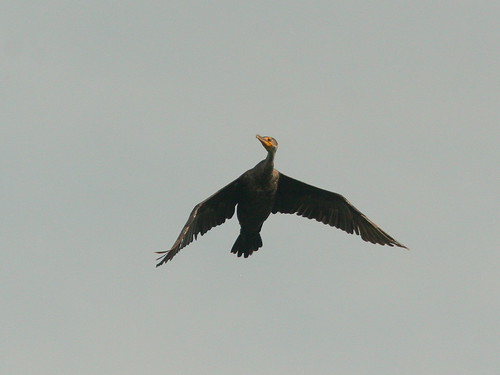
Indigo Buntings were still in full song:
We were amazed to see a male Indigo Bunting fly right up in front of an Eastern Kingbird and sing in its face:
Two immature Red-winged Blackbirds perched together and allowed me a close approach. The bird on the left bore distinctive markings that I had not seen before that (I believe) indicated it was a hatch year male (click on photo to see a more typical year old male, below the caption):
A Cotton-tailed Rabbit leapt up from under my feet, and I captured an “in-flight shot” of it, suspended in mid-air:
At first, I was unsure of the identity of this bird, but I did hear a Swamp Sparrow singing nearby, and this bird’s yellow gape and face markings were consistent with a juvenile of that species:
Common Yellowthroats were still singing in the high forbs along the trail:
Song Sparrows were numerous. They seem never to stop singing on their territories:
Only a few weeks ago, we had found dozens of Sedge Wrens singing along the paths. This morning, we found only two. Rather than singing, this one scolded softly from an elevated perch before diving into the cover of the tall grass at the south end of the lake:
Butterflies, such as this Monarch, were active:
For the next week, the heat, humidity and mosquitoes felt worse than we had endured in Florida the previous month. We ventured out to Lippold Park, another Kane County Forest Preserve situated on the east bank of the Fox River. This is usually a great spot for migrating warblers. We saw no warblers, but we were still a bit early. The mosquitoes were again out in force, and there were few birds evident. This is the end of breeding season and the time of the post-breeding molt, so locally breeding migrant birds were conserving energy in preparation for the long journey.
We did hear the scolding of several House Wrens, but were lucky enough to see only one. This appeared to be a hatch-year bird, as its plumage was dusky and it had the remnants of the yellow gape of a fledgling:
High in the canopy of a Cottonwood, a Baltimore Oriole perched quietly, keeping cool in the shade:
Thistles, which provide the late-nesting goldfinches with food and nesting materials, were in bloom. Is that an evil eye peering at me from under the flower head? No, it is a Carpenter Bee, distinguished from the Bumblebee by its almost bare and shiny black abdomen (the “eye”):
Here is a better view of the Carpenter Bee, as it gathers pollen to feed the larvae that will hatch from its large eggs hidden at the end of the tunnels it drills in dead wood. Note the narrow “waist” band of yellow hairs at the front end of an otherwise shiny black abdominal segment:
Yesterday, the heat retreated before a dry cold front that produced another open-window night. We are again happy to be in Illinois in early August!
Posted by: Ken @ 10:28 pm
Today, fast approaching the three-quarter century mark, I am penning my 300th post in Rosyfinch Ramblings. Before the days of File Transfer Protocol, and before the word “blog” was invented, I created the rosyfinch.com web suite devoted to the birds of the Sandia Mountains, near our former home in New Mexico. In those days I wrote daily updates in HTML code by hand, and uploaded strings of ASCII characters via a telephone modem. When I started using blogging software in 2006, I simply intended to record memories from my childhood in New Jersey. In my fifth post, Discovering Birds, I tried to remember how and why I ever got into bird watching.
How lucky I was to have had a father with an infectious interest in the natural world. I remembered those long walks with him in the woods (Habitats and Inhabitants) and, more recently on Father’s Day, described how I especially felt his his loss. Now we and our children try to inspire our grandchildren to put away the Wii’s, Game Boys and iPods and get outdoors. See Birders Start Young, and Early Birder.
I recounted adventures from my medical career, as the Rookie Doctor in Town , and wondered Why It’s Called Medical “Practice”. Then, suddenly and unexpectedly, I entered the field of public health, only two weeks after receiving a telegram: Greetings, You’ve Been Drafted . Providing medical care in the aftermath of Hurricane Camille, and Closing the Grand Canyon were but a couple of highlights of many exciting experiences in public health practice.
I always wanted to marry a bird-watcher, but this never happened until after I retired to the mountains of New Mexico. Don’t look so startled– Mary Lou and I just celebrated our 50th Wedding Anniversary, but she suffered as an SOB (spouse of a birder) for many years before I could say “Finally, I’m Married to a Bird-Watcher.“
We do not feel the need to travel far and wide to enjoy the beauty of nature, whether from the windows of home, in backyards, or in local patches of semi-wild land. From early childhood, I have found Beauty in the Commonplace, mostly in the good old USA. While Mary Lou and I keep life bird lists, and have taken several wildlife-oriented jaunts and cruises, neither of us has a compulsion to see all the birds of the world. We greatly enjoy seeing just that tiny sample of the avian multitude that live in, or visit our neighborhood.
Muscovy Duck in flight:
No, this is not a Frog-mouthed Four-legged Crow, but rather part of a ritualistic encounter between two male Boat-tailed Grackles in our yard. They take turns posturing, and soon one will open his mouth and flap his wings while the other points his bill to the sky. They posture and then the other bird does the same. At no time did both birds sing and flap at the same time. This went on for several minutes, until they peacefully walked away from each other and resumed catching dragonflies on the lawn. Click on image and view sequential photos of the “dance” at the “comment” link below the photo.
Boat-tailed Grackles perform a ritual “dance:”
I’m still experimenting with my little Canon A-1100 IS point-and-shoot. It packs 12.1 megapixels. This is a cropped image zoomed 4x optically to about 25 mm focal length. If you click on the photo, an image will appear below it, lightly cropped and not zoomed at all, about 6mm focal length:
Great Egret:
The Canon A-1100 takes surprisingly sharp macro photos, such as of this Garden Snail (Zachrysia provisoria):

This big Lubber grasshopper was on the glass of our patio door, again captured by my little point-and-shoot:
I had been hearing little chirps in my garage in the vicinity of the corner where I store my fertilizer and garden stuff. The chirps would stop whenever I got near, and I could not find their origin, though I presumed it might be a tree toad or frog, or maybe a Mediterranean Gecko. When potting a plant one morning I reopened a bag of potting soil. Inside were at least 6 or 7 of these little frogs, about 3/4 inch in length. Greenhouse Frogs live in plant litter and their tadpoles develop into frogs inside the eggs, so they don’t need a pool or pond to breed. They lack webbing between their toes and have been erroneously called toads. Native to the Caribbean, they have invaded most of the Florida peninsula. Listen to an mp3 of their little chirps that I heard: puca.home.mindspring.com/mp3s/Greenhouse.Frog.mp3
A Green Heron dropped by our back patio just before we departed for Illinois:
When the birding slows down there are always butterflies, and it is fun to separate the Queen…
Posted by: Ken @ 7:55 am
Wow, it’s been so hot in Florida this week! The heat was especially oppressive yesterday afternoon, and a Great Blue Heron spent over two hours roosting in the shade on our patio. It was only 20 feet away from our back window, too close for my long lens, so I “zoomed out” by stalking around the side of the house, where I could fit the entire bird in my viewfinder
Walking around the house to get a shot of the heron, I disturbed this White Ibis that had been resting in the shade of one of our mango trees. It still shows traces of juvenal plumage.
Note how the green grass reflects off the ibis’ breast:
Look at those blue eyes!:
It has been so hot here in South Florida that, instead of going out after breakfast, Mary Lou and I have been taking our “power walk” at about 5:00 AM each morning. Having failed for several days to attain BirdChaser’s “Birder’s Recommended Daily Allowance” (RDA)
Starting out, there was no wind, and the temperature was in the high eighties, almost tolerable. Before finishing the quarter-mile walk along the gravel road that leads to the West Miramar Environmentally Sensitive Land (ESL), I had already logged ten species, halfway to my target. A Blue Jay greeted me as I left the house, Mourning Doves flew over, and both Rock and Eurasian Collared-Doves cooed from rooftops. One or two Northern Mockingbirds sang rather weakly, Common Nighthawks “peent-ed” and boomed, a Loggerhead Shrike added its nasal call, and Boat-tailed Grackles filled the air with raucous singing. White Ibises and a Muscovy Duck probed for food around a garbage can that had probably been turned over by a mischievous Raccoon.
The sky had brightened a bit by the time I arrived at the edge of the canal that borders the ESL. From some distance, I captured this photo of a Great Egret, roosting in a Royal Palm at the edge of the canal (processed in Black and White with soft focus added):
Decoys are used as floats that keep the uptakes of lawn irrigation systems away from the muck at the bottom of the canal. Residents without lake frontage have to dig shallow wells for sprinkler systems. Most are Canada Geese, but one homeowner added diversity.
Faux Snow Goose on still water:
Quite a few birds showed evidence of the post-breeding molt, such as this Blue Jay, whose crest is almost non-existent: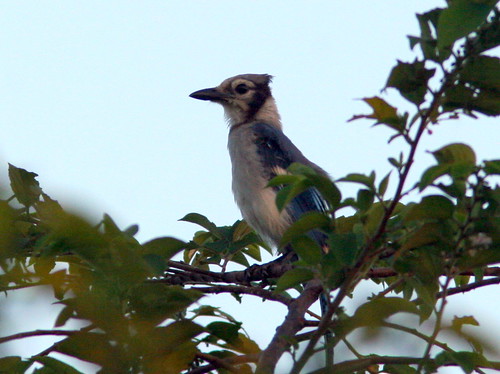
This bedraggled shrike’s feathers are worn and in disarray, ready for replacement after bringing up the youngsters:
There was movement about a hundred yards up the trail along the canal. I approached slowly and identified a pair of ground-doves, but they were very timid and flew as soon as they noticed me. My photos did not turn out very well in the harsh morning light. Click on the image to to see the characteristic rufous on its wings as it flies away.
Distant Common Ground-Dove:
As the sun came up, the temperature quickly rose into the mid-nineties. As expected this time of the year, the birds were conserving energy to produce new feathers. There was near absence of bird song. A few Eastern Towhees and Northern Cardinals did sing in the distance, a Green Heron squawked as it flew over. A Red-bellied Woodpecker called from palm trees across the canal. When I reached the path that transects the wetland, I found it muddy and overgrown– too likely to harbor hidden Cottonmouth Moccasins, so I did not venture any further. The only stand of fairly mature hardwoods is about a quarter of a mile into that area, dashing my hope of seeing a few early warblers. I had seen a Yellow-billed Cuckoo from this vantage point only last week, but it did not show this time. Neither did the Yellow-crowned Night-Herons and the Little Blue and Tricolored Herons.
By then I had almost emptied my half-liter water bottle. Deer flies began ignoring the insect repellent, diluted by perspiration. A family of Common Grackles was gathered in a tree along cross trail’s “borrow ditch.”
Look closely. Note that the young Common Grackles have dark rather than yellow eyes:
Here is a yellow-eyed adult Common Grackle for comparison. Note that its bill is slightly crossed, probably a malformation:
Grackle food– many Halloween Pennants coursed over the sawgrass:
Note signs of feather wear on the tail of this male Red-winged Blackbird, as the post-breeding molt approaches:
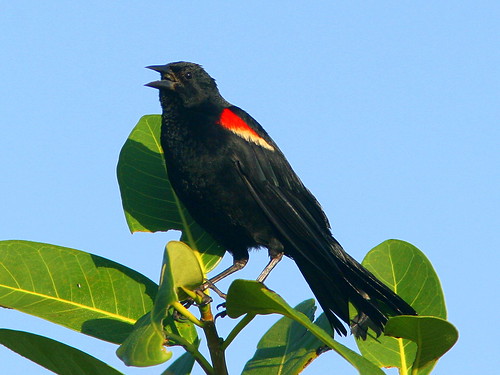
Fresh out of the nest, a fledgling Loggerhead Shrike flew into a small tree right next to the trail:
The baby shrike eyed me curiously:
After the shrike flew off, an immature Northern Cardinal took its place. Note that its bill is changing from black to the reddish color of the adult birds: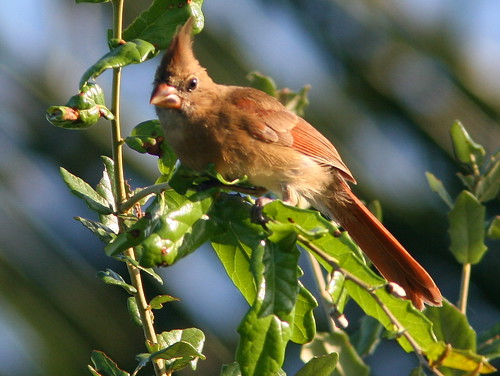
Butterflies brightened an otherwise rather dull day for birding. A Gulf Fritillary visits a flower:
White Peacocks were abundant:
I had identified Barn and Tree Swallows among the dozen or so swallows I noticed. Two small birds flew over– certainly warblers, but I could not tell their species. Only twenty species– I had barely attained my Birder’s RDA. Later that day, back home, a Snowy Egret walked the edge of our lake, and a Black Vulture glided by. Adequate nutrition, but not quite satisfying!













